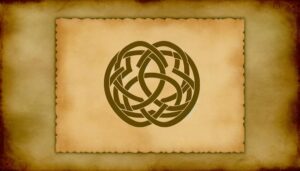How to Interpret Sword and Shield Symbols and Their Meaning
The sword and shield symbol holds significant historical and cultural meaning, representing martial prowess, defense, and honor. It has deep roots in ancient civilizations such as Rome and Greece and plays an essential role in medieval European heraldry.
Mythologically, swords often signify divine intervention, while shields symbolize protection against evil. In religious contexts, the sword represents the Word of God, and the shield, God's protection.
This symbol also embodies valor and heroism in various cultural and literary traditions. Its enduring presence in modern contexts signals a timeless appeal that continues to evoke strength and defense.
To uncover its myriad layers would be enlightening.
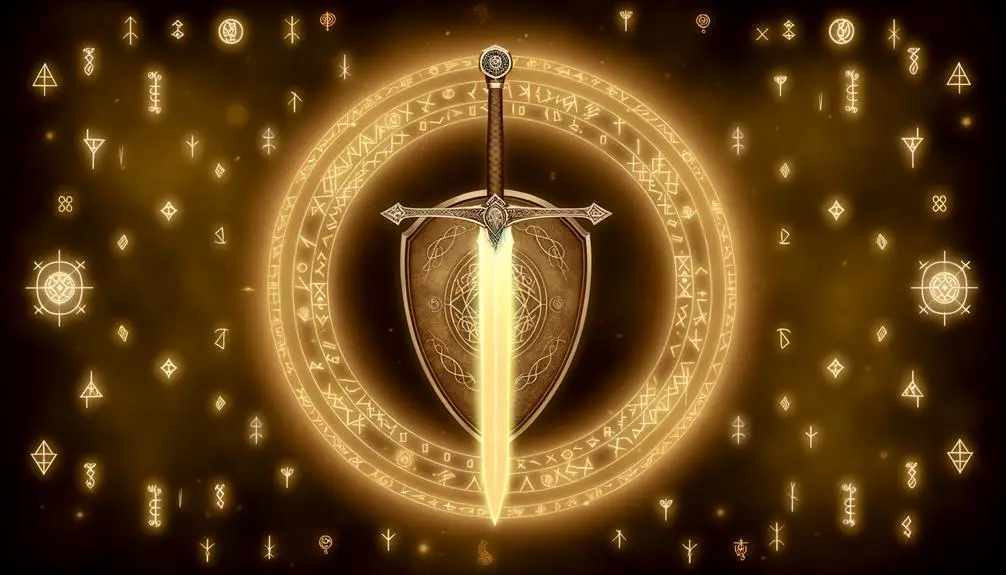
Key Takeaways
- The sword symbolizes martial prowess, aggression, and the ability to overcome challenges.
- The shield represents defense, protection, and safeguarding ideals.
- In mythological and religious contexts, the sword embodies divine intervention, and the shield signifies divine protection.
- Heraldry uses swords and shields to communicate bravery, defense, and lineage.
- Modern usage in corporate branding and media evokes strength, honor, and resilience.
Historical Significance
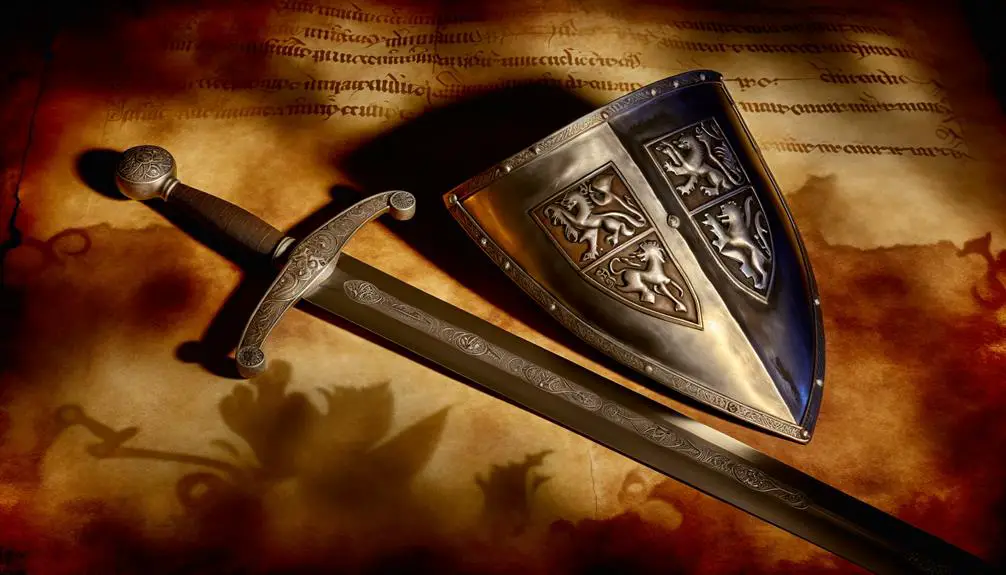
The sword and shield symbol has a rich historical significance that dates back to ancient civilizations, where it represented both martial prowess and the dual concepts of defense and aggression.
In ancient Rome and Greece, for instance, the sword and shield were integral to the armament of legionaries and hoplites, symbolizing their readiness for combat and capacity for protection.
Medieval Europe further embedded these symbols in its heraldry, where knights' crests displayed them as emblems of valor and guardianship.
Asian cultures, such as the samurai in Japan, also revered the sword as a mark of honor, skill, and duty.
Together, the sword and shield encapsulate the timeless human themes of conflict, protection, and the balance between offensive and defensive strategies.
Mythological Symbols
In the domain of mythology, swords and shields often transcend their physical utility to embody profound symbolic meanings such as divine protection, evidenced in artifacts associated with gods and guardians.
These weapons frequently represent heroic archetypes, illustrating the valor and moral integrity of legendary figures. Additionally, they are closely linked to ancient war deities, whose narratives emphasize the sacred and formidable nature of armed combat.
Divine Protection Symbolism
Across various mythologies, the sword and shield often symbolize divine protection, embodying the guardianship and strength bestowed by higher powers upon mortals. These symbols are not mere instruments of war but are imbued with sacred significance, reflecting the intervention and favor of the gods. They serve as conduits for divine will, safeguarding heroes and commoners alike from malevolent forces.
- Glowing swords, shimmering with celestial light, represent divine intervention during battles.
- Enchanted shields, inscribed with holy runes, act as barriers against evil and misfortune.
- Mythical warriors, wielding these sacred armaments, become avatars of divine justice and protection.
In this context, the sword and shield transcend their physical forms, becoming powerful emblems of divine guardianship in mythological narratives.
Heroic Archetypes Representation
Embodying the essence of heroism, mythological symbols such as the sword and shield serve as defining attributes for archetypal heroes across various cultures. These symbols are not merely tools of warfare but represent deeper virtues such as bravery, honor, and protection. The sword often signifies a hero's ability to confront and overcome challenges, while the shield symbolizes defense and safeguarding ideals.
| Culture | Sword Symbolism | Shield Symbolism |
|---|---|---|
| Greek | Strength and divinity | Protection and justice |
| Norse | Valor and warrior spirit | Guardianship and resilience |
| Japanese | Samurai honor and precision | Defensive strategy and loyalty |
This duality encapsulates the hero's journey, where offensive and defensive elements interplay to epitomize the heroic ideal.
Ancient War Deities
Ancient war deities, revered across various mythologies, often embody the martial virtues and attributes that their respective cultures held in highest esteem. These divine figures symbolize the essence of warfare, strategy, and valor, serving as paragons of strength and protection.
- Ares (Greek mythology): The personification of brutal warfare and bloodshed, often depicted with a spear and shield, symbolizing aggression and conflict.
- Mars (Roman mythology): A guardian of Rome, embodying military prowess and strategic warfare, typically shown with a gladius and shield.
- Durga (Hindu mythology): The invincible goddess wielding multiple weapons, including a sword and shield, representing the triumph of good over evil.
These deities not only reflect the cultural significance of warfare but also illustrate the profound connection between divine protection and human conflict.
Religious Interpretations
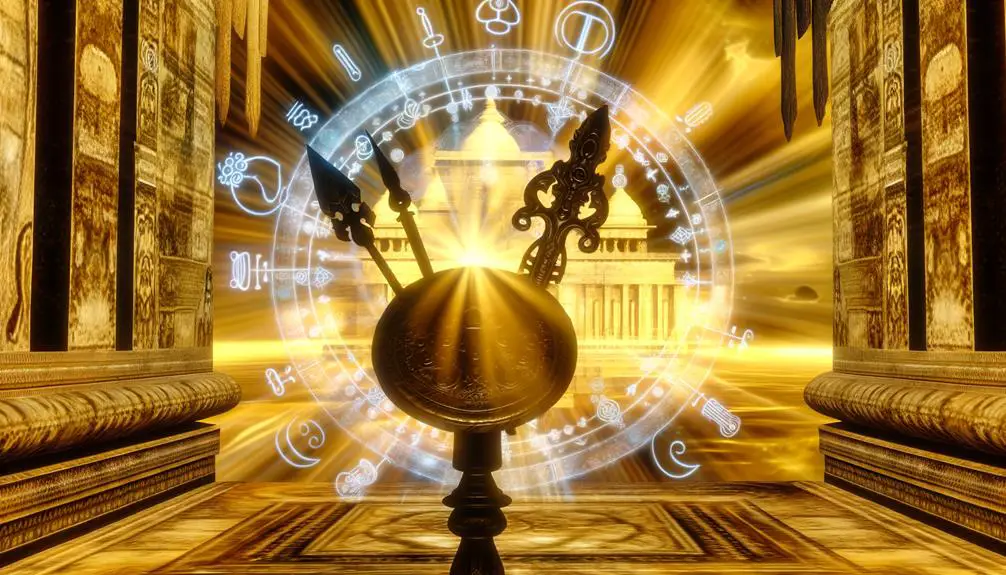
In religious contexts, the sword and shield frequently symbolize key elements of Biblical symbolism and spiritual warfare.
The sword often represents the Word of God, embodying divine truth and justice, while the shield stands for faith, offering protection against spiritual adversaries.
Together, these symbols underscore the theological concepts of defense and offense in the battle between good and evil.
Biblical Symbolism Significance
Rooted deeply in biblical texts, the sword and shield are imbued with profound symbolic meanings that reflect themes of divine protection, spiritual warfare, and the righteous defense of faith. The Bible frequently employs these symbols to illustrate God's safeguarding presence and the moral battles that believers face.
- Divine Protection: The shield represents God's protection over His people, as seen in Psalms 3:3, 'But you, Lord, are a shield around me.'
- Righteousness: The sword symbolizes the Word of God, as stated in Ephesians 6:17, 'Take the helmet of salvation and the sword of the Spirit, which is the word of God.'
- Faith: The shield of faith is described in Ephesians 6:16, 'take up the shield of faith, with which you can extinguish all the flaming arrows of the evil one.'
Spiritual Warfare Representation
The concept of spiritual warfare, as depicted through the symbolism of the sword and shield, serves to illustrate the ongoing battle between good and evil that is central to many religious beliefs.
In Christianity, the sword often represents the Word of God, which believers are encouraged to wield against spiritual adversaries. The shield, on the other hand, symbolizes faith, providing protection against malevolent forces. This duality underscores a broader theological framework where adherents are called to be both offensive and defensive in their spiritual journey.
Such imagery is not exclusive to Christianity; similar motifs appear in Islam and other faiths, emphasizing the universal recognition of a metaphysical struggle and the need for divine armor in navigating moral and ethical conflicts.
Cultural Representations
How do various cultures across history and geography depict the sword and shield, and what meanings do these symbols convey within their unique contexts?
In ancient Greek culture, the sword and shield symbolized both the warrior's honor and the collective defense of the polis.
Japanese samurai wielded the katana and tachi, embodying principles of bushido—honor, courage, and loyalty.
Meanwhile, medieval European knights used swords and shields not only as weapons but as emblems of chivalry and feudal duty.
- Ancient Greek hoplites: Bronze shields and short swords representing civic duty and personal valor.
- Japanese samurai: Elegantly crafted katanas and ornate shields symbolizing the bushido code.
- Medieval European knights: Broad swords and heraldic shields symbolizing feudal allegiance and chivalric ideals.
Heraldry and Emblems
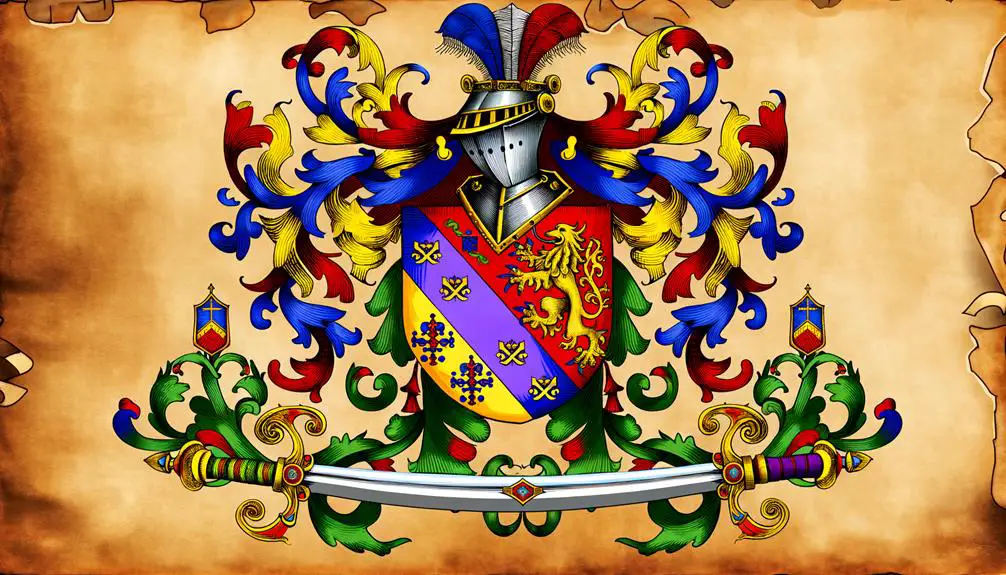
Incorporating swords and shields into heraldry and emblems historically served to communicate lineage, honor, and martial prowess, providing a visual shorthand for the values and allegiances of noble families and warrior classes. These symbols were meticulously chosen to represent specific virtues and historical narratives. Swords often signified bravery and a readiness to defend, while shields symbolized protection and resilience.
| Symbol | Meaning |
|---|---|
| Sword | Bravery, Defense |
| Shield | Protection |
| Crossed Swords | Conflict, Duel |
Heraldic designs provided an immediate understanding of an individual's or family's background, affiliations, and social standing. The strategic use of color, placement, and combination of these symbols conveyed complex messages regarding heritage and feudal responsibilities, serving as both identification and inspirational motifs during times of peace and war.
Literature and Art
Throughout literature and art, the motifs of the sword and shield have been employed to symbolize themes of conflict, protection, and valor, deeply resonating with audiences across various cultures and historical periods. These symbols are not merely decorative; they serve as powerful narrative tools that convey complex ideas and emotions.
- Epic Battles: In classic literature such as 'The Iliad,' swords and shields represent the heroism and struggles of warriors on the battlefield.
- Chivalric Romance: Medieval art and literature often depict knights wielding swords and shields, embodying ideals of honor and bravery.
- Mythical Quests: In countless myths and legends, these items are imbued with magical properties, guiding heroes through their transformative journeys.
These recurring symbols underscore their universal appeal and profound significance.
Modern-Day Usage
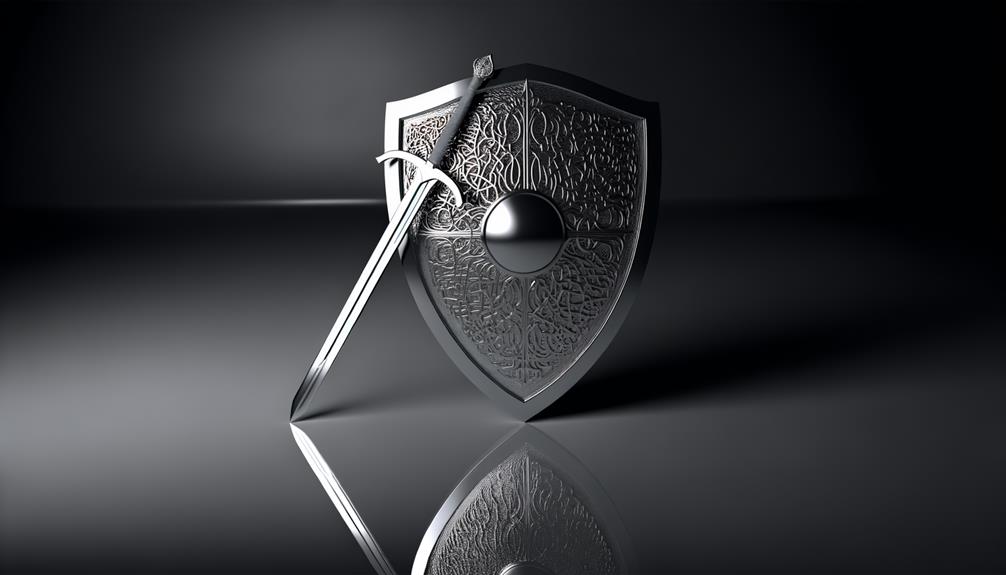
In contemporary society, the sword and shield continue to serve as potent symbols, frequently appearing in various fields such as corporate branding, popular media, and political iconography. They evoke notions of strength, defense, and honor.
Corporations often utilize these motifs to project an image of reliability and protection, appealing to consumer trust. In popular media, films and video games employ these symbols to signify heroism and conflict, resonating with audiences' intrinsic understanding of these icons.
Politically, these elements are used to symbolize national defense and integrity, reinforcing themes of resilience and sovereignty. The enduring relevance of the sword and shield in modern contexts underscores their deep-rooted cultural significance and their ability to convey powerful messages across diverse platforms.
Personal Symbolism
Beyond their widespread cultural representations, the sword and shield also hold profound personal symbolism, often embodying individual values of courage, protection, and personal integrity. These symbols are not merely artifacts of historical combat but resonate deeply within personal narratives and self-identities.
The sword can represent a person's ability to cut through adversity and obstacles, while the shield signifies the capacity to protect oneself and loved ones from harm. The intricate balance between offensive and defensive elements mirrors the human journey of maneuvering life's challenges.
- Blade gleaming under sunlight, symbolizing clarity and truth.
- Shield adorned with family crest, representing heritage and duty.
- Sword sheathed at the side, signifying readiness and restraint.
These elements collectively illustrate the nuanced layers of personal empowerment.
Conclusion
The sword and shield, much like twin pillars of antiquity, stand as enduring symbols across diverse contexts—historical, mythological, religious, and cultural. From their representation in heraldry to their evocative presence in literature and art, these icons encapsulate themes of protection and valor.
In modern times, they continue to embody personal and collective ideals, proving their timeless relevance. This enduring symbolism reflects a universal quest for strength and defense in the face of adversity.



